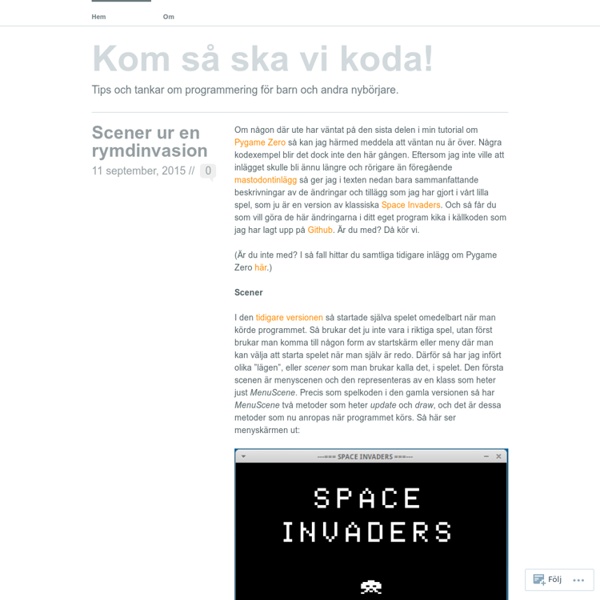



Trippel Helix Conference on Computational Thinking and Digital Competences in Primary and Secondary Education - Swedsoft Recordings from the conference is available in this playlist. The conference focus was on how to prepare our students in primary and secondary school for their future. Both national and international speakers present on the theme computational thinking and digital competence. The background to the conference is the recent revisions to the curriculum for the compulsory school in Sweden where programming is now included from grade 1 and digital competence is emphasized much more. Keynote speakers: Jeannette Wing, Avanessians Director of the Data Science Institute, Professor of Computer Science, Columbia University – “Computational Thinking” Riina Vuorikari, Research Fellow, European Commission JRC IPTS – “DigComp: the European framework helping young people to gain digital competence”.
Barnhack-med-Scratch.pdf Pokémon GO – JL Skolutveckling Pokémon GO kombinerar känslan av skattjakt med klassiska gamificationelement som att levla upp, att försöka få sin samling (Pokémons) komplett (habegäret när man kan få en unik Pokémon…) och att hela tiden få belöningar för olika delmål. Spelet kommer garanterat att få en väldigt stor del av de ungdomar som suttit stilla och spelat dataspel att ge sig ut och röra på sig, vilket är precis vad de vuxna önskat, men oftast inte lyckats med. I lördags (16 juni) släpptes spelet till den svenska marknaden (tillsammans med ca 25 andra länder). Tyvärr innebar det överbelastning för servrarna och spelet låg nere ett antal timmar under eftermiddagen i går. Jag kommer att dela upp texten i 3 delar, del 1 för föräldrar, lärare och andra som vill få en kort inblick i vad Pokémon GO är (och det kommer de flesta föräldrar och lärare att behöva veta!) Del Pokémon GO är en app till mobiltelefon (finns både för iPhone och Androidtelefoner) som har blivit en dundersuccé i de länder där den släppts. Del Ägg Lag
Tydligare om digital kompetens i läroplaner, kursplaner och ämnesplaner De nya skrivningarna ska bidra till att barn och elever utvecklar förståelse för hur digitaliseringen påverkar individen och samhället. De ska stärka elevernas förmåga att använda och förstå digitala system och tjänster, att förhålla sig till medier och information på ett kritiskt och ansvarsfullt sätt. Det handlar också om stärka förmågan att lösa problem och omsätta idéer i handling på ett kreativt sätt med hjälp av digitala verktyg. Förändringarna träder i kraft 1 juli 2018 men det är möjligt för skolorna att börja arbeta utifrån de reviderade styrdokumenten redan från 1 juli 2017. Läs mer på regeringens webbplats Grundskolan, grundsärskolan, sameskolan och specialskolan Läroplanen har förändrats i sin första och andra del, bland annat den del som heter ”Skolans uppdrag” och under rubriken ”Rektorns ansvar”. biologi fysik geografi historia idrott och hälsa kemi matematik religionskunskap samhällskunskap slöjd svenska svenska som andraspråk teknik Gymnasieskolan och gymnasiesärskolan
Monthly Code Projects for Kids Bitsbox aims to be the friendliest way for kids to learn to become programmers—even if they want to be doctors, firefighters or fairy princesses when they grow up. Learning to code is just like learning any other language; the earlier you start, the easier it is. Kids can use Bitsbox as soon as they can read and write. If you want your kid to learn guitar, you don't start with Rock Band. Most people learn hard things—languages, musical instruments, cooking—through imitation and repetition. Bitsbox is a new startup based in Boulder, Colorado. Want to learn more?
Workshopsmaterial del 1: Att jobba med Bee-Bot/Blue-Bot – Linda Mannila Bee-bot och Blue-Bot är små robotar som på ett motiverande och lättfattligt sätt tränar bl.a. problemlösning, algoritmiskt tänkande, felsökning och samarbete. De marknadsförs som introduktionsrobotar för de yngsta, men de passar minst lika bra för att konkretisera programmering till en början även för äldre. Jag har t.ex. lärare i mina projekt som jobbar med Bee-Bots med elever på åk 5-6 – och eleverna storgillar de sympatiska bottarna. Robotarna kan röra sig framåt och bakåt samt svänga höger och vänster. Bee-Botten kan enbart programmeras genom de fysiska knapparna på ryggen, medan Blue-Bot även kan programmeras med lärplatta (via Bluetooth-koppling). Båda modellerna kan köpas från t.ex. Robotarna rör sig alltid 15 cm, vilket gör att man med fördel kan använda sig av underlag med 15×15 cm rutmönster. Matematik Tallinje: Använd tejp för att skapa en tallinje på golvet och låt Bee-Botten addera eller subtrahera (gå framåt och sedan bakåt) två tal. Modersmål och språk Omgivningslära/NO
Programmering by Anne Li Dale on Prezi IKT i skolan, del 9: Att koda (programmera) i skola I flera länder har man just nu diskussioner om man ska införa detta som ett skolämne. Att koda har nära anknytning till både språk och matematik. Språk har en logisk uppbyggnad (viss mer och andra har fler undantag från logiken) och lär man sig uppbyggnaden och de regler som styr den så är det lättare att lära sig andra språk (det är en delförklaring till att det blir lättare och lättare att lära sig andra språk ju fler du kan från tidigare). Kopplingen med matematik handlar både om logik och problemlösning. Då jag inte jobbar som lärare längre har jag inte testa nedanstående tips i klassrumssituation, men jag skulle testa dem om jag började jobba som lärare igen. Appar Hakitzu Elite – en app som kombinerar programmering och dataspel. Cargo Bot En gratisapp som går ut på att du ska programmera en robot som utför arbete åt dig. Blocksworld ”visuell programmering” skulle jag kalla det för. Robo Logic 2 HD Finns en gratisversion och en fullversion som kostar 15 kr.